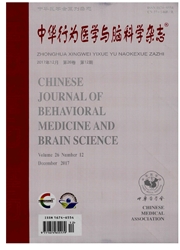

 中文摘要:
中文摘要:
目的应用影像基因组学的原理,探讨单胺氧化酶A基因串联重复序列多态性(MAOA—uVNTR)对抑郁症患者及健康对照不同面部表情识别过程中脑功能的影响。方法28例抑郁症患者及33例性别比例、年限、受教育年限匹配的健康对照,应用聚合酶链式反应(PCR)技术扩增目的基因,将61名受试者进行基因型分组,并利用1.5T功能核磁共振成像系统检测每个受试在识别喜悦、悲伤、及中性面部表情视频时的脑激活反应。结果识别悲伤面部表情时,高活性基因型健康组较低活性基因型健康组左楔叶、左额下回、右额中回、左顶下小叶脑区激活显著增强(P〈0.005,K≥10)。识别喜悦面部表情时,高活性基因型患者组较低活性基因型患者组左右壳核、左中央后回,右颞上回、右丘脑、左梭状回脑区激活降低(P〈0.005,K≥10)。结论高活性基因型与健康人群负性情绪识别的优先激活趋势及抑郁症患者正性情绪的抑制状态均存在关联性,该基因型可能是健康者罹患抑郁症的危险因素之一,同时部分导致该类患者情绪症状较为显著
 英文摘要:
英文摘要:
Objective To explore the impact of the variable number of tandem repeats of monoamine oxi- dase A gene (MAOA-uVNTR) on the intensity of brain activation (luring the recognition of facial expression in patients with depression and healthy controls. Methods 28 cases of depression,as well as 33 healthy controls who were matched in gender,age and years of education were divided into different genotypes with the methods of poly- merase chain reaction (PCR) amplification and 1. 5% agarose gel electrophoresis separation. 61 cases were scanned to compare the intensity of brain activation in the recognition of happy,sad and neutral facial expression. Results In healthy controls,cases with high-activity genotype showed increased activation in left cuneus,left inferior frontal gyrus, right medial frontal gyrus and left inferior parietal lobule in comparision with carriers of low-activity genotype. In the depressed,compared with patients with low-activity genotype,cases with high-activity genotype decreased aetivation in hilateral putamen, left posteentral gyrus, left fusiform gyrus, right superior temporal gyrus and right thalamus. Conclusion Healthy controls with high-actlvity genotype shows the trend of priority for the identification of negative emotion,this genotype may be one of the risk factors for normal people suffering from depression. Patients with high-activity genotype is associated with the inhibitory of positive emotional state,this may attribute partly to the emotional symptoms in such kind of patients more serious.
 同期刊论文项目
同期刊论文项目
 同项目期刊论文
同项目期刊论文
 Multichannel matching pursuit of MEG signals for discriminative oscillation pattern detection in dep
Multichannel matching pursuit of MEG signals for discriminative oscillation pattern detection in dep 期刊信息
期刊信息
